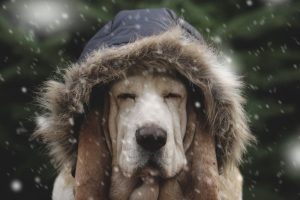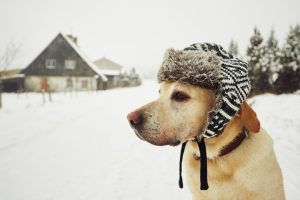It’s winter and time for snow, ice, and winter playtime. We like to take our four-footed friends out to play in the snow, and most dogs like it too! Before you take your furry buddies outside, make sure they are protected against the chill with a few easy tips.

Be Sure Your Breed Likes the Cold
Some breeds want to romp in the snow. Big, long-furred dogs were bred to work and play in chilly weather. If you have a husky, Bernese Mountain dog, Newfoundland, or Labrador retriever, you can let your pets play outside longer.
Small dogs, such as chihuahuas and miniature breeds, may not have the body mass to keep themselves warm in deep snow. Thin-furred breeds like boxers, greyhounds, Great Danes, and pit bulls, may like the cold but may need an extra layer to stay comfortable when the thermometer goes down.
How Cold is Too Cold?
Just like people, dogs have their temperature preferences. Once it drops below 32o F (0o C), small dogs, elderly dogs, and thin-furred breeds should probably stay inside. Below 20o F (-6o C), even the most active dog will want to come in where it’s warm. A few cold-weather breeds, such as huskies, malamutes, and Samoyeds, can handle weather colder than that, but keep a close eye on them if they are outside for very long.
Warm Beds and Kennels
If your dog sleeps outdoors, it should have a warm, dry kennel free of drafts. In very cold weather, heated dog beds and mats should be provided. Dogs should never be left outside without shelter. Even if your dog sleeps in the garage, make sure there is a small, warm space for it to curl up in.
Plenty of Food and Water
Just like their owners, dogs get hungry in winter because they need extra calories to keep warm. Even if your dog stays indoors most of the time, keep them well-fed during the colder months. If your dog has an outdoor kennel, consult your vet for adding additional calories.
Surprisingly, dehydration is a concern in winter as much as in summer. Because of the cold, mammals tend not to feel thirsty until they are dehydrated, and this can contribute to hypothermia. Make sure your pets have plenty of water. Heated bowls should be provided for outdoor pets, so the water doesn’t freeze.
Clean Coats and Good Grooming
Most of a dog’s insulation comes from the soft fluffy undercoat that they will shed next spring. For now, help keep your friend warm with regular grooming to brush out the dead hair and dirt so that their fur is dry and airy. Like a wet down jacket, a wet, matted coat provides no warmth at all.
If you bathe your dog yourself, make sure its coat is completely dry before taking it back outside. Groomers know the best ways to trim the outer coat so the guard hair will shed water and snow.
Boots, Coats, and Other Accessories
Not just the fashion statements of urban pets anymore, dog coats are essential for a number of breeds.
Toy and miniature breeds like chihuahuas and French bulldogs should always have a coat when the temperature drops into the 30s. Puppies of larger breeds should have coats until they are big enough to keep themselves warm.
Short-legged breeds like Corgis or terriers may have thick fur, but their height means they will be covered by snow and brush against ice and mud. Coats help keep their underfur dry and free of dirt.
Big, furry dogs such as huskies or Samoyeds may not tolerate coats and may not need them unless the weather is unusually cold, or they will be outside for extended periods of time.
Owners should consider boots for dogs who will be outdoors in icy weather. Dogs can get frostbite just like their people, and it may be difficult to see below the pads and fur. Ice can build up between their toes and cause irritation. In cities where de-icing chemicals or salt is used on the roadways, dogs’ feet can come in contact with them, and this can further irritate their feet.
Dogs must learn to wear coats and boots, so if you plan to use them, it’s best to start acclimating your dog in the fall so they will be ready to run and play when the snow begins falling.

Where Can I Learn More?
At Walk! ATX, we love helping people love their pups. Call us with questions about caring for your dog in any weather at (512) 655-9557, and we’ll answer your questions. If you can’t get your friends out in the cold weather, we’ll help you there too.